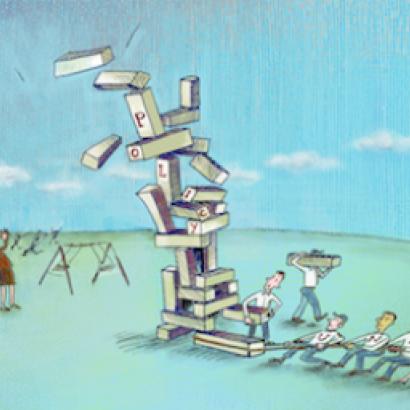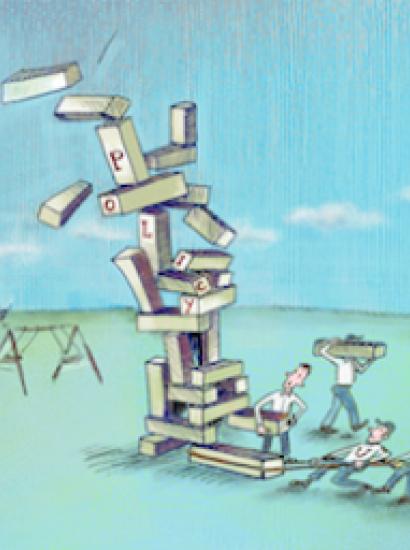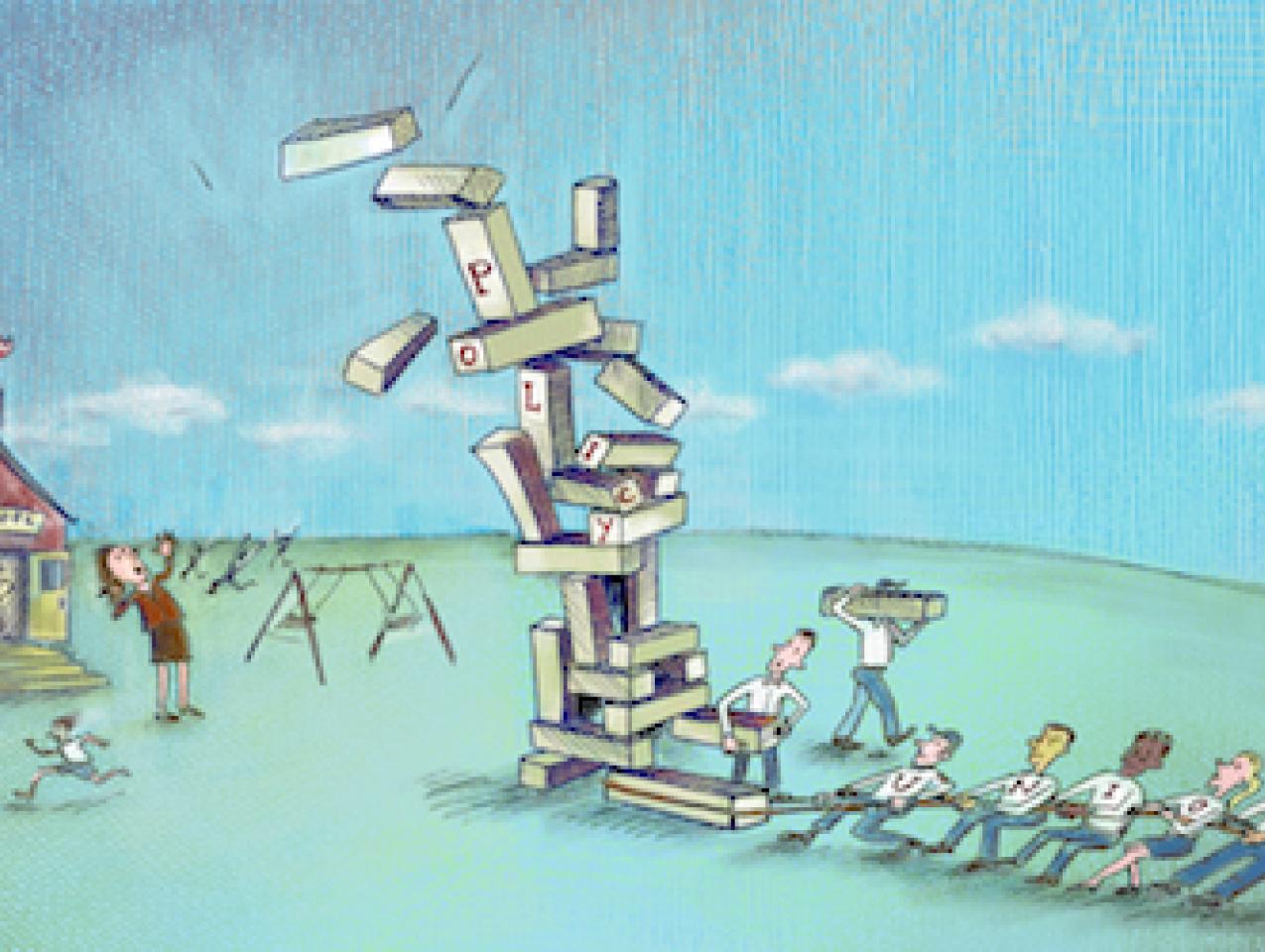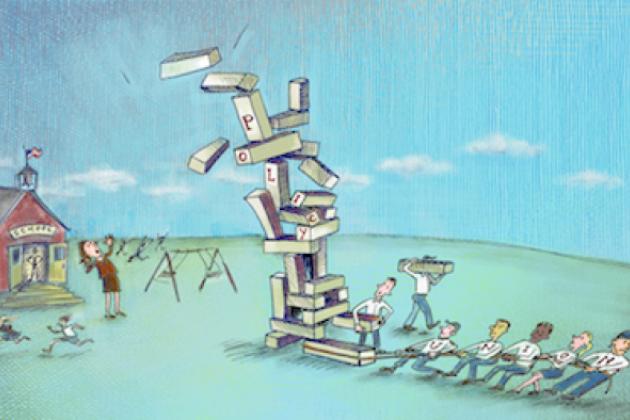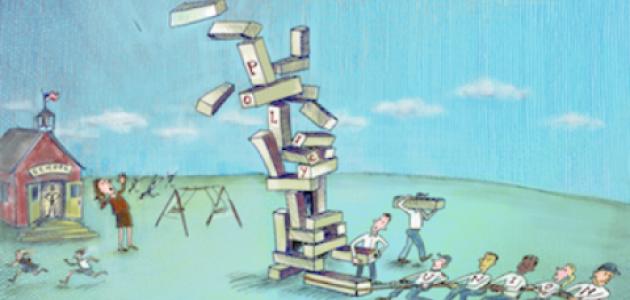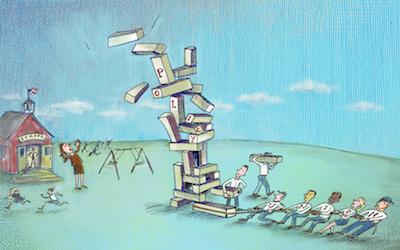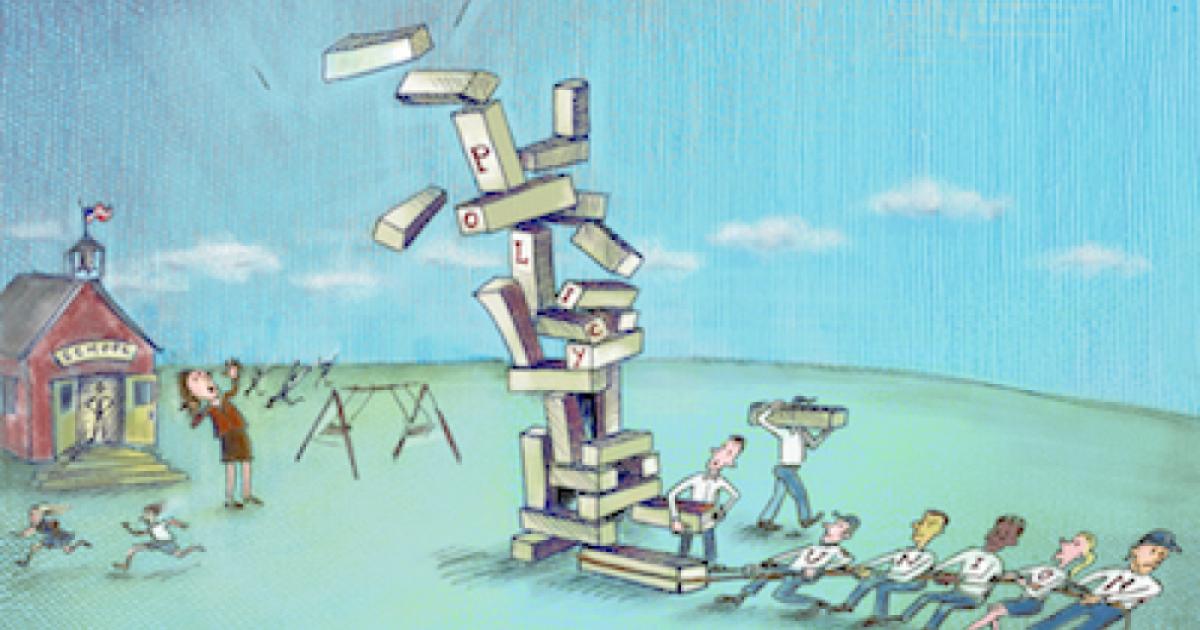Editor's note: The following essay is an excerpt from the new Hoover Press book What Lies Ahead for America's Children and Their Schools.
Since A Nation at Risk warned in 1983 of a “rising tide of mediocrity” in America’s schools, the nation has invested heavily in reform efforts to bring about significant improvement—generating countless changes to the laws, programs, structures, and curricula of public education, and spending untold billions of extra dollars. All this activity might seem to be the sign of a well-functioning democracy. But pull away the curtain and the picture is not nearly so pretty: the reforms of the last few decades, despite all the fanfare, have been incremental and weak in practice. The nation is constantly busy with education reforms not because it is responsibly addressing social problems, but because it never actually solves them and they never go away—leading to continuing demands for more reforms. This is what keeps the “education reform era” alive and kicking: not democracy, not responsibility, but failure.
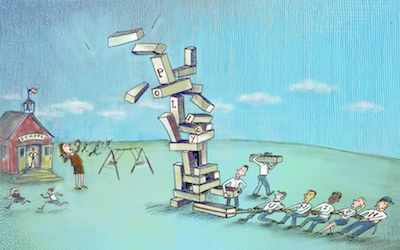
Illustration by Barbara Kelley
The reasons for this failure can be as complex as we want to make them. But the fact is, in American education—and most areas of public policy, for that matter—there are simple fundamentals at work that go a long way toward explaining the obstacles to major institutional change. The most important is the power of vested interests. In the American public school system, the key vested interests are the teachers unions: the National Education Association, the American Federation of Teachers, and their state and local affiliates—which represent the system’s key employees and are by far the most powerful groups in the politics of education. Major reform is threatening to their vested interests in the existing system, and they have used their formidable power to repel and weaken the efforts of reformers to bring real change. This is not the whole story of the modern reform era, needless to say. But it is at the heart of it.
Fortunately, for reasons I will explain, the prospects for change are much brighter in the decades ahead. And there are actions that policy makers and researchers can take that will pave the way, and help bring that change earlier rather than later.
Collective Bargaining and Ineffective Organization
As House Speaker Tip O’Neill famously noted, all politics is local. And so it is with the teachers unions. It is their locals that attract the members, money, and activists that are the ingredients of union power in politics. Their ability to attract these resources is aided immensely by collective bargaining, for this is what teachers care most about as union members and it is what ties them securely to their unions.
Collective bargaining is also profoundly important for another reason: it has enabled the unions to impose ineffective forms of organization on the schools, thus exacerbating the very problems the reform movement has been trying to correct. Among other things, local contract provisions tend to include: salary rules that pay teachers based on seniority and formal credits with no attention to performance; seniority rules for transfers and layoffs that allow senior teachers to lay claim to available jobs; onerous rules for evaluation and dismissal that virtually assure that all teachers will get satisfactory evaluations and no one will be dismissed for poor performance; and more.
These and countless other contract rules are designed to promote the job-related interests of teachers, but from the standpoint of effective organization they are simply perverse. Yet this is how America’s schools are actually organized. There is a disconnect between what the public schools are supposed to do and how they are organized to do it—and this disconnect is a built-in feature of the modern American school system, a reflection of its underlying structure of power.
Why have the districts “agreed” to ineffective organization? Partly it’s because no district wants a fight, because most work rules don’t cost them anything; and because as monopolies they have had little incentive historically to insist on effective organization anyway. But there is also a crucial political reason: school board members are elected, and the teachers unions are typically the most powerful forces in those local elections. As a result, many board members are union allies, others are reliably sympathetic to collective bargaining, and the rest have reason to fear that, if they cross the unions, their jobs are at stake.
Over the last decade, districts have had their spines stiffened a bit—by the achievement pressures of accountability, by the enrollment threats of school choice, by the fiscal demands of the recession. Yet the districts remain weak. Where districts have been willing to fight for effective organization, it has almost always occurred (and then, only sometimes) in cities—most notably Washington, D.C., New Haven, New York—where mayors have taken control of the schools. Even then, only partial progress has been made, and it is inherently vulnerable. Bold, reformist mayors ultimately leave office, as do their school chancellors, and their successors are unlikely to show the same resolve. Indeed, they may be prove to be union allies.
There are a few other districts where unusual changes are underway as well—for example, in Hillsborough County (FL), Memphis, and Pittsburgh, where heaps of money from the Gates Foundation have induced the unions to “collaborate” in teacher-evaluation reforms. But in all these places, money has been the prime inducement for union collaboration, and their job interests remain a constant threat to progress going forward. How much change is actually achieved—how many teachers are actually dismissed due to poor performance, for example—remains to be seen.
The Politics of Blocking
For well over a quarter century, the NEA and the AFT have been the most powerful groups in the politics of education—with more than four million members, formidable sums of money for campaign contributions and lobbying, well-educated activists manning the electoral trenches, and organizations that blanket the nation, allowing them to coordinate all these resources toward political ends.
Superior power doesn’t mean that the teachers unions always get the policies they want. The American system of checks and balances makes that impossible, because its multiple veto points ensure that shepherding new laws through the political process is extremely difficult. The flip side, however, is that blocking new laws is much easier, for opponents need succeed at just one veto point to win. And this is how the teachers unions have used their political power in shaping the nation’s schools: not by imposing the policies they want, but by blocking or weakening those they don’t want—and thus preventing true reform. Throughout, they have relied on their alliance with the Democratic Party to do that. The teachers unions have been the raw power behind the politics of blocking. The Democrats have done the blocking.
The modern era’s two great education reform movements, for school accountability and for school choice, attempt to bring major changes to the traditional structure of the American education system. Accountability seeks to put the spotlight on teacher performance, provide rigorous evaluations, link pay to performance, and move low-performers out of the classroom—all of which, from the unions’ standpoint, are threatening departures from a traditional system in which performance was never seriously evaluated and all jobs were secure. School choice is highly threatening to the unions too. For when families are allowed to leave the regular public schools for new options—charter schools or (via vouchers or tax credits) private schools—the regular public schools lose money and jobs, and so do the incumbent teachers in those schools. And the unions lose members.
In recent years, choice advocates cheered because Indiana and Louisiana adopted new voucher programs, and because charter schools—boosted by Race to the Top and movies like Waiting for Superman—continued to expand and attract supporters. But the bigger picture doesn’t offer much to cheer about. The choice movement has been pushing for vouchers and tax credits since the 1980s, and as of 2013 these reforms still allow only about 200,000 children to attend private schools with government assistance. Compare this to a public school population of more than 50 million children. And charter schools? The first charter schools were authorized in Minnesota in 1991, and more than 20 years later, despite all the excitement surrounding them, charters enroll less than five percent of the nation’s public school children. In most states and districts, they provide very little choice for American families and very little competition for the regular public schools. The explanation for the meager progress of school choice is very simple: the teachers unions (backed by school districts) have used their considerable power to stifle it.
The same is true for accountability. Proponents are currently excited because, in the wake of Race to the Top, 32 states have passed laws requiring that teachers be evaluated with some reference to their performance (National Council on Teacher Quality, 2012). But again, what is the big picture? The big picture is that, throughout the entire reform era, teachers have not been seriously evaluated at all. Literally 99% of them have regularly received satisfactory evaluations. And almost never have teachers actually been dismissed merely for being incompetent. Why did the nation have to wait a quarter century to get even a modicum of change? The answer, again, is that the teachers unions are opposed to performance-based evaluations (as are most districts)—and they have used their power over the years to stand in the way of genuine reform.
For accountability advocates, performance-based evaluation is their mountaintop of “success.” The rest of the educational landscape is littered with disappointments. NCLB was a monumental achievement in 2001—and the union’s greatest political defeat in the modern era—but in subsequent years it was NCLB that found itself being transformed, and ultimately eviscerated, by powerful political blowback from unions and the intransigence of the districts. Meantime, state accountability systems regularly test students—but do not, in fact, hold teachers or schools accountable for how much students learn, and rarely impose any consequences for poor performance. No one loses a job. Real pay for performance remains a rarity. And the evidence so far is that, even in states that have passed new laws requiring rigorous, performance based evaluation, virtually all teachers are getting satisfactory evaluations—just as before.
The accountability movement has surely had an impact. The nation’s focus is on performance now more than at any other time in the history of the public school system. Performance measures are made public. There is heightened pressure on school districts and teachers to raise test scores and promote learning. But the reality is that the nation’s fifty-plus-one accountability systems do not actually hold anyone accountable. They are pale reflections of what well designed accountability systems would actually do. They are the victims of power.
The Future
As long as the teachers unions remain powerful, America’s schools cannot be organized in the best interests of children. At the local level, the unions use their power in collective bargaining to impose special interest work rules that make no sense from the standpoint of effective schooling. In the policymaking process, they use their power to block or weaken reformist attempts to correct for the system’s pathologies and produce top-flight performance.
Is there any hope that the problem of union power can somehow be overcome? Under normal conditions, the answer would be no. Yet these are not normal times. American education stands at a critical juncture—and due to an unusual confluence of events, the stars are lining up in a unique configuration that augurs well for major change.
Endogenous Change
Two separate dynamics are at work. The first is arising endogenously within the education system and its politics. Reformers are gaining political strength, and the teachers unions are on the defensive like never before.
One reason is that the modern political environment has become increasingly polarized, and conservative Republicans—propelled by Tea Party devotees, the fiscal crisis, and big gains in the 2010 election—have taken on the unions like never before. In several states—Wisconsin, Indiana, Tennessee—they passed historically unprecedented legislation that limited collective bargaining and union prerogatives. This is not, however, a uniform national phenomenon. And even in these few states, control of government will eventually shift to politicians more sympathetic to labor, and they will attempt to reverse course.
Another political development is more fundamental—and more damaging, long term, to the teachers unions. This one is taking place within the Democratic Party, where the unions’ opposition to reform has led to increasing dissatisfaction—led by groups like Democrats for Education Reform, vocally expressed by moderate and liberal opinion leaders, energized by a growing network of education activists (many with roots in Teach for America), and funded by well-heeled philanthropists like Gates and Broad. This ferment hasn’t come close to converting most mainstream Democratic officeholders, who remain union allies. But President Barack Obama and his secretary of education, Arne Duncan, are clearly in the reform wing of the party, and they bucked the unions with their Race to the Top in 2009-10: a competition for funds that induced states to pursue system-bending reforms. Since then, as I’ve noted, one of these reforms--performance-based evaluations—has become the centerpiece of the nation’s reform agenda.
The tide has turned against the teachers unions, and they are in defense mode. Yet even these reformist Democrats, from Obama on down, have made it clear that they have no intention of taking action to limit collective bargaining or weaken the power of the unions. They are serious about improving the nation’s schools. But they intend to do it collaboratively within an education system filled with powerful unions that must be accommodated and made “part of the solution.” This intention is reinforced by a brute political fact: the power of the Democratic Party itself is highly dependent on the power of the unions, and thus on the continuation of collective bargaining.
The political dynamic we are now witnessing in American education, then—an endogenous development that has emerged within the system itself—is not equipped to bring about major change. It propels the education system in the right direction. But it is inherently limited, because it does little to reduce the power of the teachers unions—and they will continue to usetheir power to prevent the schools from being effectively organized.
Something more is needed. Something that does reduce union power.
Exogenous Change
That something is the worldwide revolution in information technology—an exogenous development, originating entirely outside the education system, that is among the most profoundly influential forces ever to sweep the planet. With its rooting in information and knowledge, it cannot help but transform the way students learn, teachers teach, and schools are organized. It is the future of American education—indeed, of world education.
Already, online curricula can be customized to the learning styles and life situations of individual students: giving them instant feedback on how well they are doing, providing them with remedial work when they need it, allowing them to move at their own pace, and giving them access—wherever they live, whatever their race or background—to a vast range of courses their own schools don’t offer, and ultimately to the best the world can provide. By strategically substituting technology (which is cheap) for labor (which is expensive), moreover, schools can be far more cost-effective than they are now—which is crucial in a future of tight budgets.
Because technology stands to have enormous impacts on jobs and money, the teachers unions find it threatening. And throughout the 2000s, they have used their political power—in state legislatures, in the courts—to try to slow and stifle its advance. But they won’t succeed forever. Education technology is a tsunami that is only now beginning to swell, and it will hit the American public school system with full force over the next decade and those to follow. Long term, the teachers unions can’t stop it. It is much bigger and more powerful than they are.
The advance of technology—much like the advance of globalization—will then have dire consequences for established power. There will be a growing substitution of technology for labor, and thus a steep decline in the number of teachers (and union members) per student; a dispersion of the teaching labor force, which will no longer be so geographically concentrated in districts (because online teachers can be anywhere); and a proliferation of new online providers and choice options, attracting away students, money, and jobs. All of these developments will dramatically undermine the membership and financial resources of the teachers unions, and thus their political power. Increasingly, they will be unable to block, and the political gates will swing open—to yield a new era in American education.
Hastening the Future
Whether this future arrives quickly or takes many decades will depend in part of what researchers can do to shed light on the problem of union power—and more generally, on the key roles that the teachers unions play in American education, its politics, and its reform. This is the kind of information policy makers need if they are to pursue reforms that stand to be truly effective.
To date, shockingly little research has been carried out on teachers unions. Here are some of the key areas that call out for serious study.
- What is the impact of collective bargaining on the costs of public education, the organization of the schools, and the academic achievement of students?
- What role do teachers unions play in school board elections, how successful are they in selecting sympathetic district leaders, and how does this electoral connection affect the unions’ influence in district policy making and collective bargaining?
- How do the unions use their power in the “politics of blocking” to try to stifle education reform, particularly at the state level (where authority over the schools mainly resides), how successful are they—and what factors explain their lack of success when reforms actually get adopted?
- In the southern and border states, the teachers unions often don’t have collective bargaining rights—but they are still organized, have members and money, and are quite active politically. How does their exercise of power in these contexts—at both the state and local levels—compare to what happens in the alleged “strong union” states? Are the unions really weaker in the southern and border states than they are elsewhere, and are the differences significant?
- On performance based evaluations and other post-Race to the Top reforms, how does “collaboration” with the teachers unions—in filling out the details, in the implementation process—affect the reforms’ ultimate content and impact? Does “collaboration” lead to weaker, less effective reforms?
- Does the recent reformist ferment within their party lead Democrats to embrace bold reforms of real consequence? Or does it lead them to embrace only those reforms that are “collaboratively” determined and compatible with continuing union power?
- How have the unions dealt with the rise of educational technology—how have they tried to control it, how have they tried to defeat it, in what ways have they “supported” it?
- How is the advance of technology affecting the unions’ ability to organize and wield influence, to what extent is it attracting new players into K-12 education—and overall, how is it affecting the balance of power in the politics of reform?
These topics only scratch the surface. For too long, education researchers have virtually ignored the teachers unions, focusing their attention on curricula, teaching methods, testing, and other components of the process of schooling—all of them important—but by-passing the larger considerations of power and special interest that profoundly shape the system as a whole, including its individual schools and what happens within them. If policy makers are to understand the American school system and, in particular, if they are to understand it well enough to devise truly effective reforms, this needs to change.








